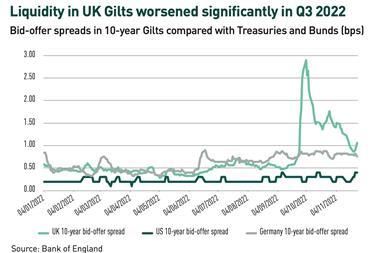Private sector defined benefit (DB) pension schemes in the UK have reported a £626bn reduction in value, according to recent statistics from the Office for National Statistics (ONS).
The ONS data indicates that the total value of DB pension schemes decreased from over £2trn at the start of 2022 to less than £1.4trn by the end of March. This represents a near one-third reduction in their overall value.
A significant factor in this decline was the drop in Gilt prices following the UK’s 2022 mini budget during fomer prime minister Liz Truss’s term, which prompted a £19bn Bank of England bailout of the pension sector.
DB schemes traditionally invested heavily in UK shares, but more recently turned to liability-driven investment (LDI) strategies based on Gilts, which were meant to be low risk.
However, the crisis which forced cash-strapped trustees to sell up to £500bn in assets, revealed previously “hidden” borrowing across UK pension schemes, which nearly toppled some funds.
Improvement in funding levels
Despite this, the ONS report highlights that the overall funding levels of these pension schemes have shown improvement. This is attributed to a faster decrease in the estimated obligations to pensioners, which are linked to Gilt prices, relative to the decline in their assets.
Lewys Curteis, principal at Barnett Waddingham, said these statistics show the DB pension scheme market is working in the manner intended by the UK regulatory regime.
“Schemes have been strongly encouraged over an extended period to invest in assets that match changes in liability values. As a consequence, the recent increase in government bond yields has materially reduced asset values for most DB pension schemes,” he said.
Curteis added that in most cases, however, this has been more than matched by a reduction in the value of DB scheme liabilities, putting the average DB scheme in a far stronger position than it has been for some time.
Elaine Torry, partner and co-head of trustee DB investment at Hymans Robertson, agreed that the rise in Gilt yields has led to a fall in the value of bond assets.
She added that while the economic backdrop is uncertain, the majority of schemes remain on track to achieve their longer term objectives with bond assets remaining attractive both as a way of managing risk within schemes and as a key part of a potential transition of pension risks to insurers.
According to Jonathan Griffith, partner and head of endgame innovation at LCP, the much improved funding position of UK pension schemes has seen increased demand from plan sponsors looking to secure pension benefits with an insurer.
He continued: “In addition, more schemes are now exploring alternative approaches that protect benefits but also build on this funding improvement as they seek to share value with members, scheme sponsors, and wider stakeholders.”
Read the digital edition of IPE’s latest magazine





































No comments yet